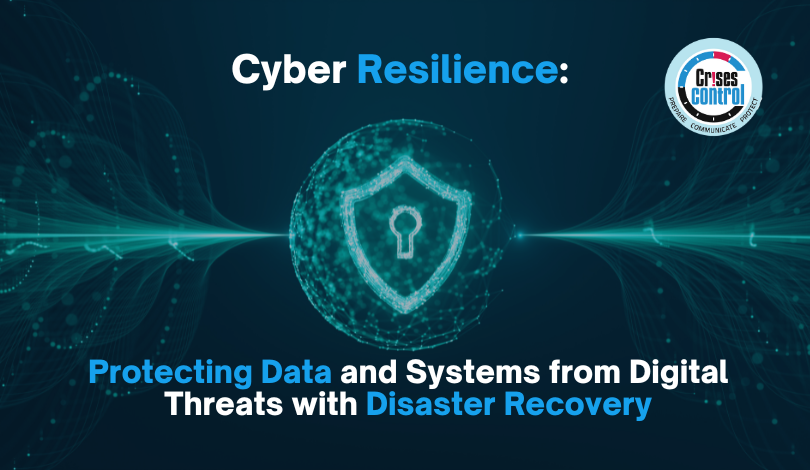Organisations need to adopt robust strategies to protect their valuable data and systems from digital threats. One such strategy is cyber resilience, which combines proactive measures, incident response, and disaster recovery planning to ensure business continuity. In this blog post, we will explore the concept of cyber resilience and its significance in safeguarding data and systems. Additionally, we will delve into the role of disaster recovery in achieving cyber resilience and how Crises Control can be a valuable tool in this regard.
Understanding Cyber Resilience
Cyber resilience refers to an organisation’s ability to prepare for, respond to, and recover from cyber incidents effectively. It encompasses a holistic approach that goes beyond mere prevention and focuses on maintaining essential functions during and after an attack. By integrating cybersecurity measures, incident response plans, and disaster recovery strategies, organisations can enhance their cyber resilience and mitigate the impact of potential threats.
The Importance of Cyber Resilience
In today’s interconnected world, where cyber threats are constantly evolving, cyber resilience is vital for organisations of all sizes. A single cyberattack can have severe consequences, including financial losses, reputational damage, and disruption of operations. Cyber resilience provides a proactive defense mechanism that enables organisations to detect threats early, respond promptly, and recover swiftly, minimising the impact on their business and stakeholders.
Key Components of Cyber Resilience
To achieve effective cyber resilience, organisations must focus on the following key components:
Threat Assessment and Prevention
The first step is identifying potential threats and assessing vulnerabilities. Organisations need to conduct comprehensive risk assessments and implement preventive measures to mitigate these risks. This includes deploying robust firewalls, antivirus software, and intrusion detection systems to protect against common cyber threats.
Incident Response and Recovery
In the event of a cyber attack, organisations must have well-defined incident response plans in place. These plans outline the steps to be taken when an incident occurs, including incident detection, containment, eradication, and recovery. By having a structured incident response process, organisations can minimise the impact of an attack and swiftly restore normal operations.
Disaster Recovery Planning
Disaster recovery planning is an integral part of cyber resilience. It involves creating comprehensive strategies and procedures to recover critical systems and data in the event of a catastrophic incident. This includes regular data backups, off-site storage, and the ability to restore systems quickly. A well-designed disaster recovery plan ensures minimal downtime and allows organisations to resume operations efficiently.
Implementing Cyber Resilience Strategies
To implement cyber security plans effectively, organisations should follow these steps:
Assessing Vulnerabilities
Start by conducting a thorough assessment of your organisation’s vulnerabilities. Identify potential entry points for cyberattacks, such as outdated software, weak passwords, or unpatched systems. Regular vulnerability assessments and penetration testing can help uncover weaknesses that need to be addressed.
Developing Incident Response Plans
Develop robust incident response plans that outline the roles and responsibilities of key personnel during a cyber incident. Define clear communication channels, establish escalation procedures, and conduct regular training exercises to ensure everyone understands their roles and can respond effectively when needed.
Creating Disaster Recovery Plans
Design comprehensive disaster recovery plans that encompass the recovery of critical systems and data. Determine recovery time objectives (RTOs) and recovery point objectives (RPOs) to guide the restoration process. Regularly test and update these plans to account for changes in technology, infrastructure, or business operations.
Cyber Resilience Best Practices
To enhance cyber resilience, organisations should adhere to the following best practices:
Regular Backup and Data Protection
Implement a robust backup strategy to protect critical data. Regularly back up data and store it securely, both onsite and offsite. Additionally, consider implementing encryption techniques to protect data in transit and at rest.
Employee Training and Awareness
Invest in comprehensive cybersecurity training for employees to raise awareness about common threats and best practices. Educate employees about phishing attacks, social engineering techniques, and the importance of strong passwords. Encourage a culture of cybersecurity awareness throughout the organisation.
Network Security Measures
Implement strong network security measures, including firewalls, intrusion detection systems, and antivirus software. Regularly update and patch software and firmware to address any known vulnerabilities. Utilise multi-factor authentication to strengthen access controls.
The Role of Disaster Recovery in Cyber Resilience
Disaster recovery plays a critical role in achieving cyber resilience. While preventive measures focus on minimising the risk of an incident, disaster recovery ensures business continuity in the event of an attack. By having robust disaster recovery plans in place, organisations can quickly restore systems, recover data, and resume operations, thereby reducing the impact of cyber incidents.
Leveraging Crises Control for Cyber Resilience
Crises Control is a leading provider of incident management and emergency notification solutions. With its comprehensive platform, organisations can streamline their cyber resilience strategies. By utilising Crises Control’s features, including real-time incident reporting, automated notifications, and coordinated response plans, organisations can effectively manage cyber incidents and minimise their impact.
Conclusion
In today’s digital landscape, cyber resilience is paramount for organisations seeking to protect their data and systems from digital threats. By implementing proactive measures, robust incident response plans, and comprehensive disaster recovery strategies, organisations can enhance their ability to withstand cyber incidents. Leveraging tools like Crises Control further strengthens an organisation’s cyber resilience, enabling them to respond swiftly and recover effectively. To safeguard your organisation’s digital assets and maintain business continuity, prioritise cyber resilience and take the necessary steps to fortify your defences.
Request a live demo or get in touch with our experts to discover how Crises Control can assist you in achieving cyber resilience. Protect your valuable assets and ensure business continuity by fortifying your defences today.








